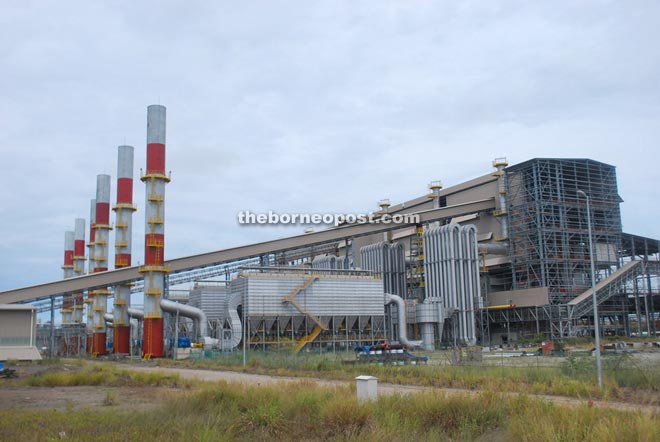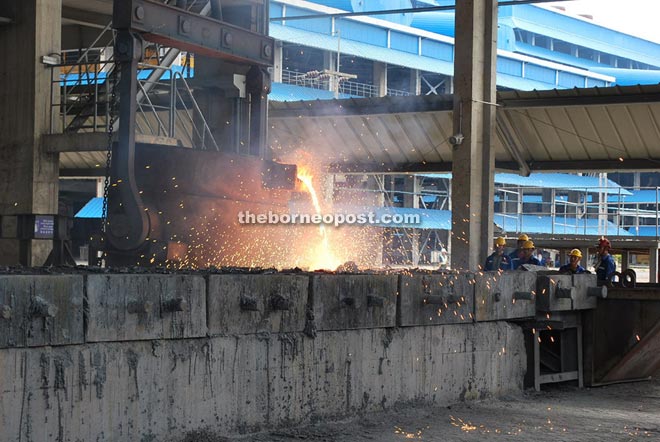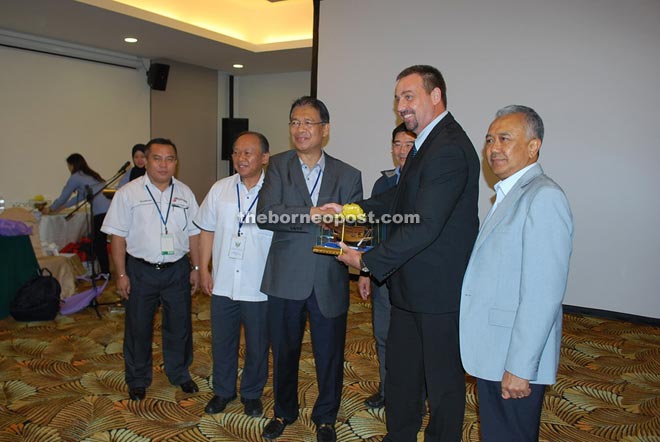
Pertama’s smelting complex is projected to have its first stream of production on February 2016.

Production in full steam at OM Materials Sarawak ferroalloy smelting plant.

Talling (second right) receives a souvenir from Julaihi for his briefing on project implementation and employment opportunities.
SAMALAJU: The risk of investment at Samalaju Industrial Park (SIP) could be predicted in terms of sustainable resources, says Pertama Ferroalloys Sdn Bhd general manager Andrew Talling.
“We know we have the power supply from Bakun and Murum dams for 20 years and that is the big advantage in this competitive world,” he told reporters when asked why the company has decided to invest in Sarawak Corridor of Renewable Energy (SCORE).
The world, he said, was currently facing rising cost of power supply and it would be an advantage for heavy industry players, in particular, to utilise sustainable energy sources.
Pertama Ferroalloys sited at a 180ha land with total investment of US$360 million is among six foreign companies that have set up their plants at SIP. Its first production is expected to come on stream in February next year. The plant will produce manganese ferroalloy, silicon ferroalloy and silica fume of up to 240,000 tonnes per annum.
The five companies are Tokuyama Malaysia Sdn Bhd, Press Metal Bintulu Sdn Bhd, OM Materials (Samalaju) Sdn Bhd, Sakura Ferroalloys Sdn Bhd and Iwatani-SIG Industrial Gases Sdn Bhd.
Talling said the second element was logistics because SIP had a purpose-built port for heavy industries. Samalaju Industrial Port is a purpose-built port to cater primarily to energy-intensive industries.
He added that trust-building was the key factor that prompted them to invest at SIP and the government responded well to the needs of investors, and it was easy to negotiate with the state government.
Meanwhile Press Metal Group chief executive officer Datuk Paul Koon Poh Keong said they were happy to be a part of SIP.
“The whole idea of SCORE is using renewable energy, so I guess it is a great vision by the state government.
“We are also progressing well because we receive good support from a very stable state government. We have been progressing very quickly since the last few years and support from the various departments is also there,” he said.
In addition, the location of SIP was ideal and basically Press Metal’s products were for growth regions like South East Asia, Japan and Korea, he said.
He said SIP offered attractive packages with its renewable energy which would make the company more competitive.
Meanwhile, State Planning Unit deputy director Buckland Bangik earlier said in his briefing that SIP had an area of more than 8,000ha, one of the biggest industrial parks in the country and a centre for heavy and energy-intensive industries.
He said SIP was being developed with industrial infrastructure including a dedicated port and a new township which would be transformed into an industrialised innovation township by 2030.
”The industrial transformation and repositioning of SIP will progress over five key areas, each building on the previous to leverage success, enhance synergies and unlock future potential.
“The five key areas include existing raw material processing, enhance raw material processing, downstream value add, near-term manufacturing and next generation manufacturing.”
Buckland said SIP was being developed through a steady inflow of Foreign Direct Investments (FDIs) to achieve Sarawak’s objective of attaining a high income and advanced economy through industrialisation.
On Monday, a media group led by Assistant Minister of Industrial Development (Investment and Promotion) Datuk Julaihi Narawi made a visit to SIP to get the latest update on the project implementation there.
